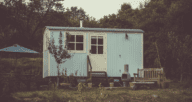DIY Home Building: 4 Ways to Build a House Yourself
- Published on
- 7 min read
-
 Jody Ellis, Contributing AuthorClose
Jody Ellis, Contributing AuthorClose Jody Ellis Contributing Author
Jody Ellis Contributing AuthorJody Ellis is a freelance writer with more than 15 years of experience in the writing industry. Her work includes copywriting and content marketing for real estate professionals, stories covering real estate trends and housing markets, and varied articles on decor and design. In addition to buying and selling several homes herself, she's also owned and managed rental properties, and previously worked in mortgage lending.
-
 Taryn Tacher, Senior EditorClose
Taryn Tacher, Senior EditorClose Taryn Tacher Senior Editor
Taryn Tacher Senior EditorTaryn Tacher is the senior editorial operations manager and senior editor for HomeLight's Resource Centers. With eight years of editorial and operations experience, she previously managed editorial operations at Contently and content partnerships at Conde Nast. Taryn holds a bachelor's from the University of Florida College of Journalism, and she's written for GQ, Teen Vogue, Glamour, Allure, and Variety.
Building your own house can be an incredibly gratifying experience. Putting in those unique finishes and creating exactly what you want — knowing that you did it all with your own two hands — adds another level of pride to homeownership. Being able to build a house on your own might seem like an impossible dream, but there are actually several ways to build a house without breaking the bank.
DIY home building can be surprisingly affordable, especially if you already have land to build on. HomeLight explored some of the top options in do-it-yourself home construction — from building a tiny house to getting contractor help for the big-ticket items but still finishing the details on your own. We also spoke with experienced brokers and real estate agents to get their take on the best ways to build a house yourself.
Shell homes
For buyers who don’t want to deal with issues such as putting in a foundation or framing, hiring a contractor to put up a shell can speed up the building process while still leaving you the opportunity to do the bulk of the work yourself. The contractor comes in and puts in the foundation, frames the house, and then leaves the rest to you.
Veteran real estate agent Sandi Van Camp, who is based out of New York State and has 23 years of experience in the industry, says that buyers who enlist a contractor to have a shell home built should keep in mind that all zoning regulations that contractors must adhere to still apply to buyers working on their own house.
“You will still be required to have a zoning inspector sign off on the work,” she says. “So while it’s certainly something you can do, some contractors are leery of building shell homes because if a buyer isn’t qualified to do the work, it could compromise the work the builder has already done.”
The cost for a shell home can vary widely by square footage and region, as well as by the number of subcontractors you might need to hire.
Broker Mary Stewart, who is based near Houston and has 44 years of experience in the real estate industry, says that building your own home can be a viable choice for those seeking an affordable way to become homeowners. “While I’ve worked primarily with buyers who hire contractors for a home build, there are options for those seeking to do everything themselves,” she says.
Stewart suggests that if a buyer really wants to purchase a shell home, they should consider going smaller. “One option is to go through a company that delivers small shell homes,” she says.
If you decide to go with a shell home, you’ll need to already own the land you want to build on, and make sure that the property you buy or lease allows this type of building. You’ll also need all the proper tools for doing the work yourself.
Container homes
Homes made from shipping containers are increasingly popular these days, and with good reason. With an average price of $1,800 to $8,300 per container, they can be one of the most affordable housing options on the market, especially if you are able to do most of the finish work yourself.
Many cargo facilities keep a backstock of containers that they can no longer use, and there are several online resources for container purchases. Reusing old containers not only saves money but also supports eco-friendly building practices, helping homeowners to reduce their carbon footprint.
You have the option to purchase refrigerated containers, which are insulated, or regular containers, which you’d need to insulate yourself. Containers can also be easily combined, going from the standard 8-by-40-foot container to a full-sized home, all at a fraction of the cost of a traditional build.
You can do the interior framing and finish work yourself, or hire subcontractors, which is still less expensive than building a house from the ground up. Container homes can be built relatively quickly, they have an ideal shape for building, and they are made of durable steel.
For DIY builders who want to purchase a container home, you’ll first want to make sure you have land and space for it prior to purchase, and you’ll need to figure out the logistics of getting the container delivered to your property.
While most states now allow container homes, double-check your state and county for any potential restrictions.
Tiny homes
The tiny home movement doesn’t appear to be slowing down, and if you already own a piece of land, building your own tiny house is an affordable way to create a space to call your own. Tiny homes usually cost between $30,000 to $60,000 on average, depending on design and amenities.
There are myriad online sites that offer plans for tiny houses, complete with supply lists and the costs of various finishes and custom work. Some people build their tiny homes directly onto trailers, making them more portable, or you can put in a foundation and build a permanent structure.
“Tiny homes can be a good choice for some people,” says Stewart, “Especially if you’re the type of person who likes to be outdoors a lot and doesn’t need much inside space.”
Stewart says that while traditional mortgage financing isn’t usually available for tiny homes, buyers can consider consumer loans if they need to finance their purchase. “Most people pay out-of-pocket,” she says.
If you decide to go tiny, make sure you have your building plan sorted out before you start, in addition to all the supplies and tools you’ll need. And for those builders wanting to put their tiny home on a trailer, be sure to get a trailer that is specifically made for tiny houses; otherwise, you’ll end up with problems with the building flexing and potentially getting damaged every time you move it.
Home kits
With DIY home kits, your new home is delivered directly to your door, ready for assembly.
A kit home can be a good choice if you aren’t quite sure about how to gather everything you might need to build on your own, or if you just want to be able to construct your new home quickly. Prices vary depending on the size of the home, but they cost less than traditional builds with a contractor — sometimes much less if you’re able to do all the work yourself.
Kits can be purchased from builders, many of whom offer custom planning and a wide range of sizes, or even from online retailers like Amazon. The price range fits just about any budget, as well, with some kits available to purchase for under $10,000.
Construction can be completed fairly quickly, with some builders getting the home up in a matter of weeks as opposed to the months-long timeline of traditional builds.
If a home kit sounds appealing, be sure to thoroughly research what the kit you purchase includes, as plans between kits can vary greatly. Some kits do not include foundation or roof materials, so you will want to verify everything that’s included in a kit before buying it. If you aren’t experienced with things like plumbing or electrical, you’ll also need to factor in additional costs for subcontractors, as well as make sure your kit home meets any zoning requirements in your area.
Save big with a DIY home
No matter what route you decide on for building your own home, you’re likely to spend a lot less than if you purchased an existing house or hired a contractor to build for you. A DIY home means you can build within your budget, customize the house to fit your lifestyle, and have the satisfaction of knowing that you put in the work yourself. “There are so many variables,” adds Van Camp. “It really just depends on what you want and what you can afford.”
Frequently asked questions about building a house
Where do I start when building a house myself?
Site preparation and surveying are crucial first steps in building a house. They lay the groundwork — literally and figuratively — for a safe, stable, and well-constructed home. Neglecting these steps can lead to costly mistakes, structural issues, and environmental concerns down the road.
Is site preparation important? Can I skip it?
Site preparation matters. There are several problems that might arise if you fail to prepare your site properly. Site preparation helps with the following:
- Ensures Stability: Preparing the site helps eliminate potential risks like soil instability or uneven ground, which can cause foundation problems.
- Improves Drainage: Grading the land prevents water from pooling around the foundation, reducing the risk of water damage and mold.
- Facilitates Construction: Clearing debris, vegetation, and rocks creates a clean, accessible space for construction teams and equipment.
- Prevents Legal Issues: Proper site preparation ensures compliance with zoning laws, setback requirements, and environmental regulations.
What is surveying when building a house yourself?
Surveying defines property boundaries, ensures structures are positioned correctly, and identifies geographical or topographical challenges. It also helps locate utility lines and potential hazards, saving time and money during construction.
How much would it cost to prepare and survey the construction site?
Costs can vary based on location, property size, and the complexity of the site. Here’s a general breakdown:
1. Land Clearing
- Tree and vegetation removal: $200 – $2,000 (depending on density and tree size)
- Stump removal: $100 – $150 per stump
- Debris hauling: $70 – $95 per tree
2. Grading and Excavation
- Land grading: $1,023 – $3,338 (based on slope and area size)
- Excavation for foundation: $1,662 – $6,728
3. Surveying
- Property survey: $800 – $5,500 (depends on lot size and location)
- Topographical survey: $2,000 – $6,500 (optional but helpful for uneven terrain)
4. Soil Testing
- Basic soil test: $672 – $2,155 (to determine soil composition and load-bearing capacity)
5. Drainage Solutions
- Installing drainage systems: $2,118 – $7,099 (depends on water flow needs)
Total Estimated Costs
On average, homeowners can expect to spend $5,000 to $15,000 on site preparation and surveying for a standard home build. For complex sites, costs can rise significantly.
Header Image Source: (Trong Nguyen / Shutterstock)
- "How Much Does It Cost to Install a Drainage System In Your Yard? [2024 Data]," Angi (June 2024)
- "How Much Does Soil Testing Cost? [2024 Data]," Angi (November 2024)
- "How Much Does a Land Survey Cost? [2024 Data]," Angi (October 2024)
- "How Much Does It Cost to Level a Yard? [2024 Data]," Angi (September 2024)
- "How Much Does Tree Removal Cost? [2024 Data]," Angi (October 2024)
- "Zoning and Land Use Laws," Justia
- "26 Kit Homes You Can Buy and Build Yourself," Bob Vila (April 2024)




